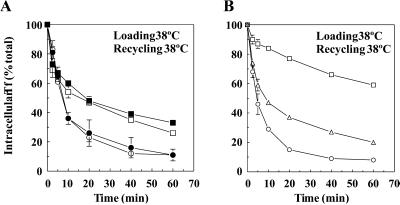Figure 4.
Inhibition of Tf recycling by dynts is not due to defective endosome acidification. (A) dynwt (circles) and dynts (squares)-expressing cells were loaded with 125I-Tf for 1 h at 38°C. Cell surface-associated 125I-Tf was removed at 0°C by the acidic-neutral wash procedure using either MES buffer (open symbols) or acetate buffer (closed symbols). The cells were then reincubated at 38°C, and the release of 125I-Tf was measured. Intracellular 125I-Tf is plotted as a percentage of total endocytosed 125I-Tf (n = 2, mean ± SD). The experiments shown are representative of three independent experiments, each with duplicate samples. The acetate treatment assured the release of Fe3+ from intracellular 125I-Tf. dynts inhibited the release of 125I-Tf irrespective of acetate or MES treatment. Lack of endosome acidification thus can not explain the results. (B) As a positive control for this procedure, dynwt-expressing cells were loaded for 1 h at 38°C with 125I-Tf in the absence (○) or presence (▵ and □) of 100 nM of concanamycin A, a vacuolar proton pump inhibitor. Cell surface-associated 125I-Tf was removed at 0°C by the acid-neutral wash procedure using either MES buffer (□) or acetate buffer (○ and▵). Cells were then reincubated at 38°C in the absence (○) or presence (▵ and □) of 100 nM concanamycin A and release of 125I-Tf was measured. Intracellular 125I-Tf is plotted as a percentage of total internalized 125I-Tf. The results shown (n = 2, mean ± SD) are representative of five independent experiments. The acetate treatment restored 125I-Tf recycling by concanamycin A-treated cells, illustrating the effectiveness of this procedure.

